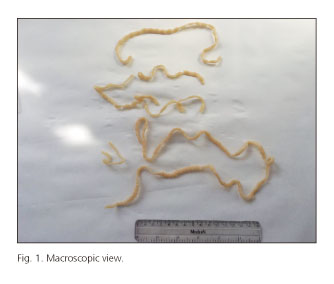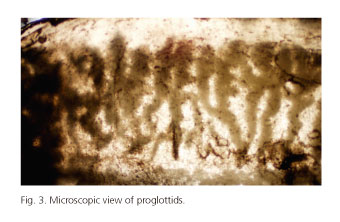My SciELO
Services on Demand
Journal
Article
Indicators
-
 Cited by SciELO
Cited by SciELO -
 Access statistics
Access statistics
Related links
-
 Cited by Google
Cited by Google -
 Similars in
SciELO
Similars in
SciELO -
 Similars in Google
Similars in Google
Share
Revista Española de Enfermedades Digestivas
Print version ISSN 1130-0108
Rev. esp. enferm. dig. vol.107 n.7 Madrid Jul. 2015
PICTURES IN DIGESTIVE PATHOLOGY
Taenia saginata: An imported case
Taenia saginata: descripción de un caso importado
Juan Francisco López-Caleya1, Sebastián N. Contreras2 and Laura Martín-Rodrigo3
Department of 1Internal Medicine and 2Emergencies. Hospital de Cabueñes. Gijón, Asturias. Spain
3Department of Internal Medicine. Fundación Hospital de Jove. Gijón, Asturias. Spain
Introduction
In developed countries, such as Spain, parasitic infections have some interest in cases due to immigration, travel to endemic countries, and international adoptions.
Case report
Male, 33-year-old, Spanish, civil engineer who has lived 18 months in Ivory Coast for work. Currently, he has returned to Spain and has perianal itching and diffuse cramp-like abdominal pain. There is no fever, he has diarrhea, and his latest bowel movement suggests the presence of a large worm.
The examination revealed mild pain on deep palpation of the right iliac fossa. The tests show slight eosinophilia (750 eosinophils per microliter).
The macroscopic view of the parasite suggests Taenia (Fig. 1). Microbiological analysis describes it as Taenia saginata (T. saginata).
Discussion
Tapeworms cause two types of infection in humans, depending on whether the person is the worm's intermediate or permanent host. In the case of the latter, the tapeworm is an adult individual that inhabits the small intestine, such as T. saginata (1).
The cow, acting as intermediate host, ingests the eggs present in the soil and the larvae develop in the cow's tissues. The person, being the permanent host, ingests the meat of the animal, undercooked (kebabs, steak tartare) and develops the worm in its adult form (Fig. 2).
Most cases are asymptomatic. Sometimes there may be cramp-like abdominal pain, constipation or diarrhea, and peripheral eosinophilia.
The collection of three different stool samples every other day is recommended. By injecting Indian ink in each proglottid, it is possible to see its uterine invaginations using a microscope (Fig. 3) and thus reach a final diagnosis.
Depending on the number, if it is between 7 and 13, it is T. solium; if between 15 to 20, it is T. saginata (3).
The treatment of choice is Praziquantel pods.
References
1. Craig P, Ito A. Intestinal cestodes. Curr Opin Infect Dis 2007;20:524-32. [ Links ]
2. Floch MH. Tapeworm (Cestode) Infection (Beef): Taenia saginata. Netter's Gastroenterology 2010;181:472-3. [ Links ]
3. Vila J, Álvarez-Martínez MJ, Buesa J, et al. Diagnóstico microbiológico de las infecciones gastrointestinales. Enferm Infecc Microbiol Clin 2009;27:406-11. [ Links ]











 text in
text in 





